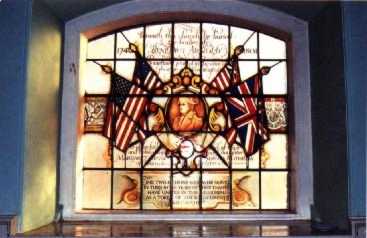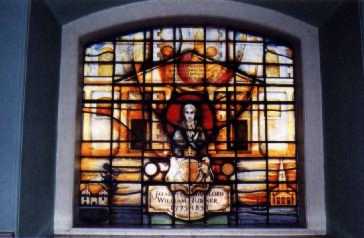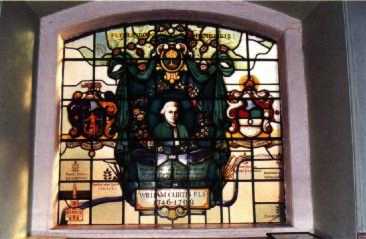 |
|
Home Page  Virtual Tour
Virtual Tour  Modern Stained Glass
Modern Stained Glass
|
St Mary's Modern
Stained Glass
Benedict Arnold - William
Blake - JMW Turner - William
Curtis
Between
1976 and 1982 four new stained glass windows were added to the ground floor
of the Church. They commemorate some of the famous people associated with
the church. In each case they were made by John Hayward of Edenbridge,
Kent. The glass on the ground floor had been plain since the 1940s. Stefan
Hopkinson, the Vicar of Battersea during the Second World War, knew how
to find the silver lining in every cloud. He writes in his memoirs, Encounters:
Among
the improvements in the church's interior decoration is one other with
which I am rather proud to be associated. When we arrived [in the parish]
the ground floor windows were filled with very bad Victorian stained glass,
which was not only ugly in itself, but excluded the daylight. But the air
raids began, and one morning a bomb fell nearby. I went to investigate.
There was considerable damage, but the church was unharmed -- at least,
until I picked up a stone and smashed all the Victorian glass.
|
|
 General
Benedict Arnold is one of the most famous (or infamous) figures of the
American War of Independence. At first he fought for the British, then
switched sides to fight for the Americans before returning to fight for
the British once again. As a result of this, he is remembered as a kind
of 'Lord Haw Haw' figure in American culture. The centre of the window
itself is a monochrome portrait of General Arnold, and below it are the
arms of George Washington, in whose army Arnold (at times) fought. The
four flags in the centre are, left to right, the modern 'Star 'n' Stripes',
an earlier version of the American flag with thirteen stars representing
the thirteen states, the 'Union flag' of 1777, and the modern 'Union Jack'.
This window was donated by Mr Vincent Lindner of New Jersey, USA. Benedict Arnold, his wife and daughter are buried in the crypt, where their
resting place is marked by a further memorial plaque. More details
about Arnold, and some further links, can be found here. General
Benedict Arnold is one of the most famous (or infamous) figures of the
American War of Independence. At first he fought for the British, then
switched sides to fight for the Americans before returning to fight for
the British once again. As a result of this, he is remembered as a kind
of 'Lord Haw Haw' figure in American culture. The centre of the window
itself is a monochrome portrait of General Arnold, and below it are the
arms of George Washington, in whose army Arnold (at times) fought. The
four flags in the centre are, left to right, the modern 'Star 'n' Stripes',
an earlier version of the American flag with thirteen stars representing
the thirteen states, the 'Union flag' of 1777, and the modern 'Union Jack'.
This window was donated by Mr Vincent Lindner of New Jersey, USA. Benedict Arnold, his wife and daughter are buried in the crypt, where their
resting place is marked by a further memorial plaque. More details
about Arnold, and some further links, can be found here.
|
William Blake
(1757-1827)
 William
Blake was married to Catherine Boucher in the church in 1782. The original
wedding certificate can be viewed here. It surprises many to learn that
the wife of one of our greatest poets was illiterate, and could only made
her mark with a cross. The wedding is suggested by a wedding ring between
two pencil portraits. The one of the left is William drawn by Catherine,
the one on the right, Catherine as drawn by William. The rest of the window
design attempts to give expression to the diversity of Blake's talents
as a painter, engraver, printer and poet. Among his more insistent themes
are those concerned with seeing the great and the small and the idea that
all things contain a male and female principle. He is also the author of
the words of the hymn, 'Jerusalem', now a very popular hymn at weddings
in the church today. At the bottom right is a picture of the Houses of
Parliament to mark the connection with the late William Hamling, MP, in
whose memory the window was given. There is more information about Blake
and his work here. William
Blake was married to Catherine Boucher in the church in 1782. The original
wedding certificate can be viewed here. It surprises many to learn that
the wife of one of our greatest poets was illiterate, and could only made
her mark with a cross. The wedding is suggested by a wedding ring between
two pencil portraits. The one of the left is William drawn by Catherine,
the one on the right, Catherine as drawn by William. The rest of the window
design attempts to give expression to the diversity of Blake's talents
as a painter, engraver, printer and poet. Among his more insistent themes
are those concerned with seeing the great and the small and the idea that
all things contain a male and female principle. He is also the author of
the words of the hymn, 'Jerusalem', now a very popular hymn at weddings
in the church today. At the bottom right is a picture of the Houses of
Parliament to mark the connection with the late William Hamling, MP, in
whose memory the window was given. There is more information about Blake
and his work here.
|
J. W. M.
Turner (1775-1851)
 It
is said that JMW Turner painted some of his riverscape studies of light
from the vestry window of the church. He lived in a terrace house across
the river in Chelsea, which can be seen from the churchyard, and was rowed
over everyday by his servant in order that he might paint. 'Turner's Chair',
in which he sat to paint, is now one of the chairs in the sanctuary of
the church. The window contains an early self-portrait of Turner set against
a drawing of the West end of the church. This is lightly treated on white
glass in a style suggested by Turner's paintings, in red, orange and golds.
Below the portrait are reminders of his close association wit the Royal
Academy. At bottom left are shown the original works of Morgan's Crucibles,
a local industry, the donors of the window. More of Turner's pictures
can be seen here. It
is said that JMW Turner painted some of his riverscape studies of light
from the vestry window of the church. He lived in a terrace house across
the river in Chelsea, which can be seen from the churchyard, and was rowed
over everyday by his servant in order that he might paint. 'Turner's Chair',
in which he sat to paint, is now one of the chairs in the sanctuary of
the church. The window contains an early self-portrait of Turner set against
a drawing of the West end of the church. This is lightly treated on white
glass in a style suggested by Turner's paintings, in red, orange and golds.
Below the portrait are reminders of his close association wit the Royal
Academy. At bottom left are shown the original works of Morgan's Crucibles,
a local industry, the donors of the window. More of Turner's pictures
can be seen here.
|
William Curtis
(1746-1799)
 William
Curtis is a famous Eighteenth Century botanist, who collected many of his
samples in the churchyard. The portrait of Curtis is framed with a chaplet
of flowers form his book, Flora Londinensis. Below the portrait
is the epitaph of the original headstone (now lost) and above the emblem
of the Royal Horticultural Society. To the left are the arms of the Society
of Apothecaries, in whose gardens (now known as the Chelsea Physic Garden)
Curtis was Demonstrator of Botany. To the right there are the arms of the
Linnean Society, of which he was a founder member. At the bottom of the
window is a schematic map of the Thames between Battersea and Berdmonsey
showing the approximate positions of Curtis' gardens. William
Curtis is a famous Eighteenth Century botanist, who collected many of his
samples in the churchyard. The portrait of Curtis is framed with a chaplet
of flowers form his book, Flora Londinensis. Below the portrait
is the epitaph of the original headstone (now lost) and above the emblem
of the Royal Horticultural Society. To the left are the arms of the Society
of Apothecaries, in whose gardens (now known as the Chelsea Physic Garden)
Curtis was Demonstrator of Botany. To the right there are the arms of the
Linnean Society, of which he was a founder member. At the bottom of the
window is a schematic map of the Thames between Battersea and Berdmonsey
showing the approximate positions of Curtis' gardens.

|
 General
Benedict Arnold is one of the most famous (or infamous) figures of the
American War of Independence. At first he fought for the British, then
switched sides to fight for the Americans before returning to fight for
the British once again. As a result of this, he is remembered as a kind
of 'Lord Haw Haw' figure in American culture. The centre of the window
itself is a monochrome portrait of General Arnold, and below it are the
arms of George Washington, in whose army Arnold (at times) fought. The
four flags in the centre are, left to right, the modern 'Star 'n' Stripes',
an earlier version of the American flag with thirteen stars representing
the thirteen states, the 'Union flag' of 1777, and the modern 'Union Jack'.
This window was donated by Mr Vincent Lindner of New Jersey, USA. Benedict Arnold, his wife and daughter are buried in the crypt, where their
resting place is marked by a further memorial plaque. More details
about Arnold, and some further links, can be found
General
Benedict Arnold is one of the most famous (or infamous) figures of the
American War of Independence. At first he fought for the British, then
switched sides to fight for the Americans before returning to fight for
the British once again. As a result of this, he is remembered as a kind
of 'Lord Haw Haw' figure in American culture. The centre of the window
itself is a monochrome portrait of General Arnold, and below it are the
arms of George Washington, in whose army Arnold (at times) fought. The
four flags in the centre are, left to right, the modern 'Star 'n' Stripes',
an earlier version of the American flag with thirteen stars representing
the thirteen states, the 'Union flag' of 1777, and the modern 'Union Jack'.
This window was donated by Mr Vincent Lindner of New Jersey, USA. Benedict Arnold, his wife and daughter are buried in the crypt, where their
resting place is marked by a further memorial plaque. More details
about Arnold, and some further links, can be found  William
Blake was married to Catherine Boucher in the church in 1782. The original
wedding certificate can be viewed here. It surprises many to learn that
the wife of one of our greatest poets was illiterate, and could only made
her mark with a cross. The wedding is suggested by a wedding ring between
two pencil portraits. The one of the left is William drawn by Catherine,
the one on the right, Catherine as drawn by William. The rest of the window
design attempts to give expression to the diversity of Blake's talents
as a painter, engraver, printer and poet. Among his more insistent themes
are those concerned with seeing the great and the small and the idea that
all things contain a male and female principle. He is also the author of
the words of the hymn, 'Jerusalem', now a very popular hymn at weddings
in the church today. At the bottom right is a picture of the Houses of
Parliament to mark the connection with the late William Hamling, MP, in
whose memory the window was given. There is more information about Blake
and his work
William
Blake was married to Catherine Boucher in the church in 1782. The original
wedding certificate can be viewed here. It surprises many to learn that
the wife of one of our greatest poets was illiterate, and could only made
her mark with a cross. The wedding is suggested by a wedding ring between
two pencil portraits. The one of the left is William drawn by Catherine,
the one on the right, Catherine as drawn by William. The rest of the window
design attempts to give expression to the diversity of Blake's talents
as a painter, engraver, printer and poet. Among his more insistent themes
are those concerned with seeing the great and the small and the idea that
all things contain a male and female principle. He is also the author of
the words of the hymn, 'Jerusalem', now a very popular hymn at weddings
in the church today. At the bottom right is a picture of the Houses of
Parliament to mark the connection with the late William Hamling, MP, in
whose memory the window was given. There is more information about Blake
and his work  It
is said that JMW Turner painted some of his riverscape studies of light
from the vestry window of the church. He lived in a terrace house across
the river in Chelsea, which can be seen from the churchyard, and was rowed
over everyday by his servant in order that he might paint. 'Turner's Chair',
in which he sat to paint, is now one of the chairs in the sanctuary of
the church. The window contains an early self-portrait of Turner set against
a drawing of the West end of the church. This is lightly treated on white
glass in a style suggested by Turner's paintings, in red, orange and golds.
Below the portrait are reminders of his close association wit the Royal
Academy. At bottom left are shown the original works of Morgan's Crucibles,
a local industry, the donors of the window. More of Turner's pictures
can be seen
It
is said that JMW Turner painted some of his riverscape studies of light
from the vestry window of the church. He lived in a terrace house across
the river in Chelsea, which can be seen from the churchyard, and was rowed
over everyday by his servant in order that he might paint. 'Turner's Chair',
in which he sat to paint, is now one of the chairs in the sanctuary of
the church. The window contains an early self-portrait of Turner set against
a drawing of the West end of the church. This is lightly treated on white
glass in a style suggested by Turner's paintings, in red, orange and golds.
Below the portrait are reminders of his close association wit the Royal
Academy. At bottom left are shown the original works of Morgan's Crucibles,
a local industry, the donors of the window. More of Turner's pictures
can be seen  William
Curtis is a famous Eighteenth Century botanist, who collected many of his
samples in the churchyard. The portrait of Curtis is framed with a chaplet
of flowers form his book, Flora Londinensis. Below the portrait
is the epitaph of the original headstone (now lost) and above the emblem
of the Royal Horticultural Society. To the left are the arms of the Society
of Apothecaries, in whose gardens (now known as the Chelsea Physic Garden)
Curtis was Demonstrator of Botany. To the right there are the arms of the
Linnean Society, of which he was a founder member. At the bottom of the
window is a schematic map of the Thames between Battersea and Berdmonsey
showing the approximate positions of Curtis' gardens.
William
Curtis is a famous Eighteenth Century botanist, who collected many of his
samples in the churchyard. The portrait of Curtis is framed with a chaplet
of flowers form his book, Flora Londinensis. Below the portrait
is the epitaph of the original headstone (now lost) and above the emblem
of the Royal Horticultural Society. To the left are the arms of the Society
of Apothecaries, in whose gardens (now known as the Chelsea Physic Garden)
Curtis was Demonstrator of Botany. To the right there are the arms of the
Linnean Society, of which he was a founder member. At the bottom of the
window is a schematic map of the Thames between Battersea and Berdmonsey
showing the approximate positions of Curtis' gardens.